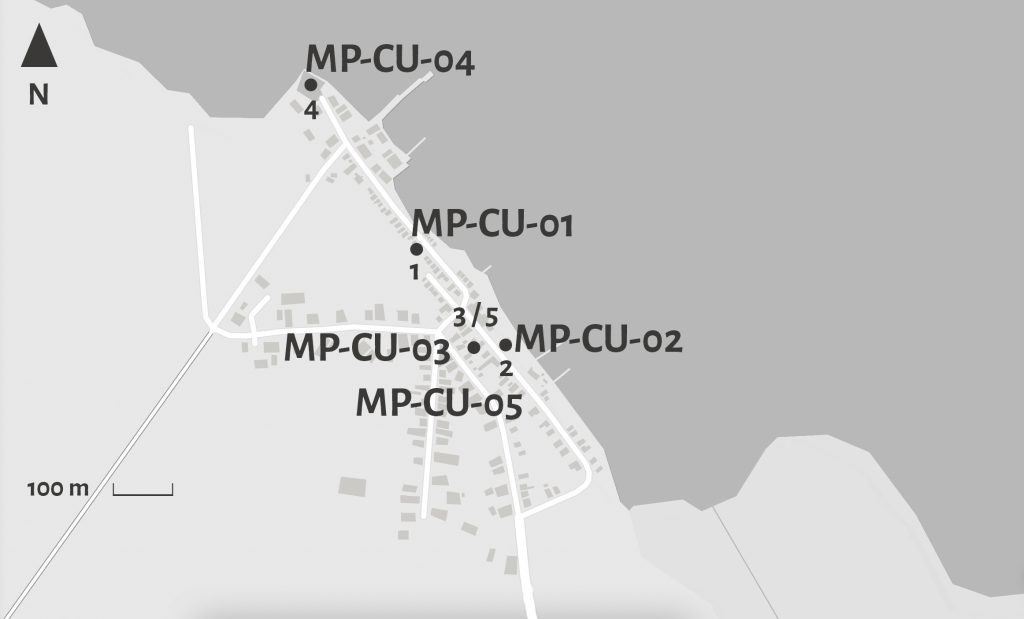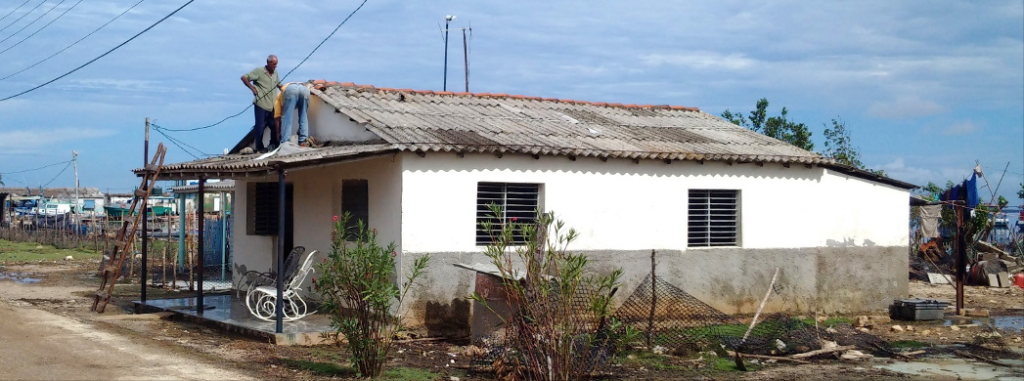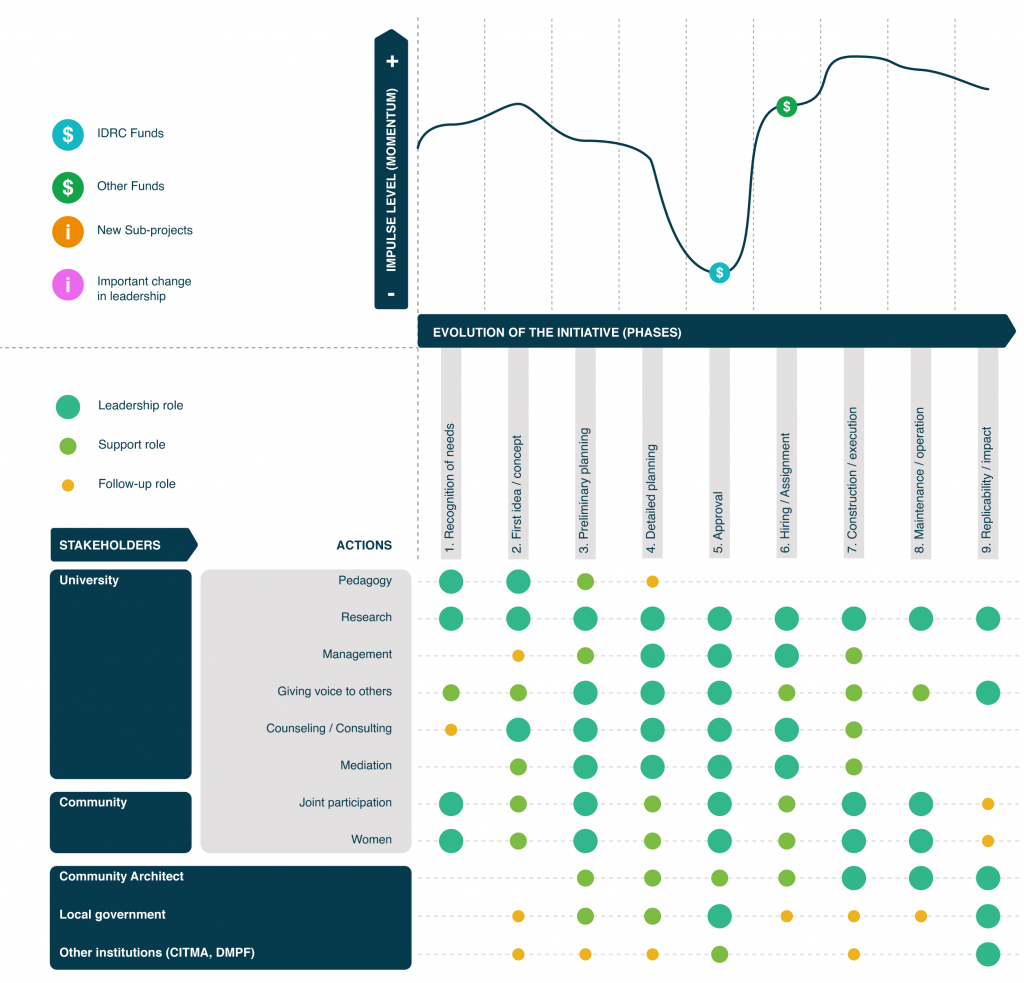Building on popular knowledge: Triggering housing adaptation to climate change with technical support and a tool library
by Gonzalo González, Universidad Central Marta Abreu de las Villas, Cuba

[table id=1 /]

Fig 2. Reinforcement of the roof in case of future hurricanes. Photo: G. González.
Summary
Each year, rising sea levels, hurricanes, and tropical storms damage numerous homes in Carahatas, a fishing community of 591 inhabitants in Cuba. In 2017, Hurricane Irma affected more than 60% of the houses in the village. Repairs are usually carried out autonomously by residents who have little technical knowledge and lack access to specialized tools. This micro-project aimed to trigger more robust housing repairs by sharing the construction knowledge that already exists in Carahatas, and facilitating the construction process. Academic partners, with the support of community members, studied the practices and strategies traditionally used to protect dwellings and belongings from the effects of natural hazards. Then, with the help of the Community Architect, they documented technical knowledge and imparted it to the community. In partnership with project leaders and local governmentrepresentatives, they also created a community tool library, which offers free use of specialized construction tools and technical support in home adaptation procedures. This locally driven project helped hazard-proof 67 houses, which improved the quality of life of 214 residents. The project also contributed to develop construction skills and knowledge among community members. The local government is now including this climate change adaptation initiative in its next edition of the Carahatas Master Plan.
Description
The housing construction model in Cuba is generally characterized by the do-it-yourself method. In Carahatas, special construction practices result from the coexistence with the sea and its effects on buildings. The strategies must comply with Cuban climate change regulations and policies as well as being adapted to local risks, traditional practices, and materials. They include interventions to protect houses and belongings against flooding and storm surges, such as natural barriers and elevated foundations, and measures to protect against strong winds, such as reinforced structural joints and anchored lightweight roofs (Figs. 1, 2, and 5). However, these local adaptive techniques and strategies are only incorporated in a few housing interventions. Not all residents are able to apply them – especially women and those most at risk of natural hazards, who often lack technical knowledge and access to specialized tools. This results in an urgent need to improve housing and construction knowledge in Carahatas, evident in the still-visible damage of recent hurricanes and the effects of sea-level rise on the housing stock. This microproject therefore aimed at sharing technical advice and tools to expand the adoption and application of these local adaptive practices within the community. The university members initiated and coordinated a partnership with local leaders, with their knowledge and construction skills, as well as the Community Architect Office of the Municipality, with its legal and technical expertise. The micro-project supports these local adaptive processes in two ways: first, by legitimizing and sustaining effective local adaptive practices; and second, by providing free access to construction tools that promote autonomy and reduce labor costs (Fig. 4). Ultimately, the project strengthened cooperation within the community, provided technical assistance to those most at risk, and enhanced the role of women in construction activities.
Local implementation and evolution
The micro-project began with a local leader who was spontaneously advising his neighbors on adaptive construction practices. The university took this initiative as a starting point and created a partnership between the university’s ADAPTO project members, the municipal government, and the community architect to identify, study and implement local adaptive construction strategies at a greater scale. The first presentation of the micro-project idea to the community generated high expectations and ambitious goals in the face of community needs. These goals were later focused on more pressing rehabilitation needs in the wake of Hurricane Irma, which damaged 60% of the housing stock. The university, along with the community and community architect, carried out research on existing local adaptive construction practices to document and technically improve them. Due to bureaucratic difficulty in obtaining funding for the tool library, the partnership expanded to include Habitat 2, an international university-community project aiming to improve the management of human settlements. This resolved a financial predicament and restored momentum and interest in the project (Phase 5, Fig. 3).
With the best local adaptative construction practices being identified and technically improved and the tool library ready to use, the micro-project university leaders triggered housing rehabilitation in four steps:
1. First, they reached out to the most vulnerable members of the community to offer assistance (this outreach campaign was performed jointly with a women’s association that was created as part of the ADAPTO micro-project “Women of the Sea”).
2. They made an initial technical visit to define the solutions and construction tools that would need to be borrowed from the community library, as well as the type of social and technical support needed.
3. Technical advisors from the community architect office, sometimes at the request of the grantees, made regular visits to provide technical assistance and monitor progress. This was followed closely by researchers at the Central University.
4. Finally, an advisor from the Community Architect office assessed the construction process and quality of the final outcome in order to identify the best adaptive practices to be legitimized in the Carahatas Master Plan.
In the process, the university members disseminated the results and contributed to policy improvement. They delivered presentations to the government, and institutions such as the Planning Institute and the Ministry of the Environment, on the national policy for adaptation to climate change. They also contributed to the development of the next Carahatas Master Plan; the municipal Department of Physical Planning will include the project in its viable local strategies for adaptation to climate change.
Stakeholder participation
Stakeholders’ roles in the project evolved over time (Fig. 3). The university members, consisting of five professors and six students from the ADAPTO team, were particularly present in the initial phases: instigating field studies, reviewing regulations and policies, and ensuring coordination between different actors. They also helped find additional financial resources, plan the work, and disseminate the results. The local leaders and community members also played a central role in supporting and implementing the project activities. In accordance with traditional gender roles in the community, women made and disseminated key decisions related to the adaptation strategy and its design and contributed to the male-led construction process. With respect to institutional actors, the municipal government legitimized the project and referred to it as an example of efficient and sustainable work in the Carahatas Master Plan. The Community Architect supported the planning stage and research on the adaptation strategies. His role became particularly important towards the end of the project, when he offered technical guidance to the numerous rehabilitation projects. It is worth mentioning that the Community Architect is particularly central in the Cuban context, where this role legitimizes the project and ensures its sustainability. Other institutions, such as the Ministry of Science (CITMA) and the Ministry of Physical Planning (DMPF), contributed to the legal formalization of the initiative.

Results
- Evaluated, documented, and classified traditional construction strategies and techniques for the Community Architect. These strategies are in the process of being integrated in the next Master Plan of Carahatas.
- Improved the quality of life and sense of security of 214 residents in 67 rehabilitated houses.
- Established a library of 62 specialized tools that are free for community members to use, which optimizes household resources (in labor and cost savings).
- Trained 12 community members in construction skills.
- Improved the community’s ability to plan repairs, with a focus on supporting women-led households and other vulnerable groups. Community members now know who can help repair buildings, who still needs help, and what tools are available to them.

Lessons learned
Overall, this project has effectively triggered a collective action and incorporated local knowledge into official policy – a milestone in climate change adaptation policy in Cuba. The study and improvement of existing construction practices, in this case, the community-based strategies and techniques for housing renovation, can ensure compliance with regulations for areas at high risk of flooding and can provide a baseline for the organization of appropriate and low-cost interventions. In the Cuban model, involving the municipal government in an entirely local initiative can legitimize a project without reducing the community’s autonomy. It can also allow the community to directly influence municipal risk reduction, climate change adaptation, and environmental policies. Incentives, like free tools for community use, can trigger high levels of spontaneous community participation by lowering organizational, technical, and financial barriers. Ultimately, the combination of a tool library, expertise-sharing, and community involvement can reduce both construction time and costs, as well as reliance on the government for minor post-flood repairs. The synergy between activities that are traditionally gender-based, in this case construction done by men and an outreach effort led by women, can help direct efforts toward the most vulnerable groups. This resulted in additional support for the most vulnerable during the housing rehabilitation process. Women’s outreach efforts have also proven particularly helpful in ensuring the equitable sharing of resources, such as construction tools.
Future actions and replicability
Houses in Carahatas will likely require ongoing repairs due to recurring natural hazards. The micro-project legitimized and expanded existing adaptive practices and made these repairs – and future ones – more robust to natural hazards, contributing to the community’s long-term resilience and quality of life.
This micro-project’s sustainability depends, in part, on continuous community access to construction tools and building materials. The project is in the process of being integrated into the next Carahatas Master Plan. The next phase of this micro-project would be to consider alternative approaches for residents of particularly high-risk areas. The initiative may be replicated among other small-scale coastal settlements in Cuba, and other local governments have shown interest in doing so. The Ministry of Science (CITMA) and the Ministry of Physical Planning (DMPF) are evaluating the project for potential replication in other localities. The university members are writing a journal article and will present the ADAPTO projects at the UCLV 2021 International Convention.
 |  |


